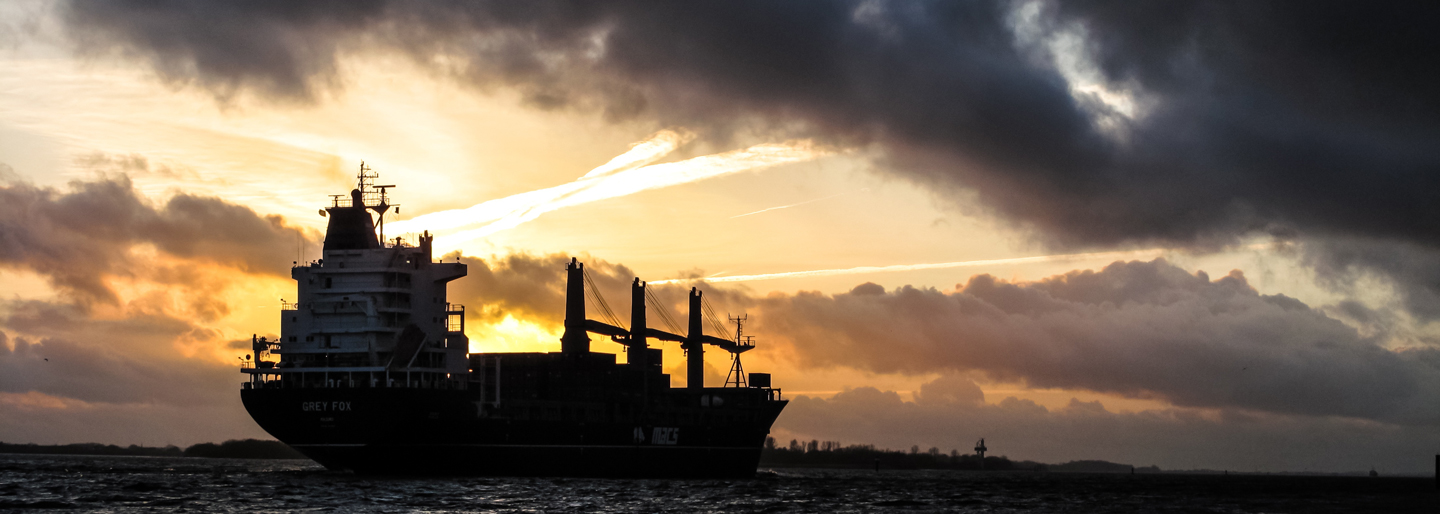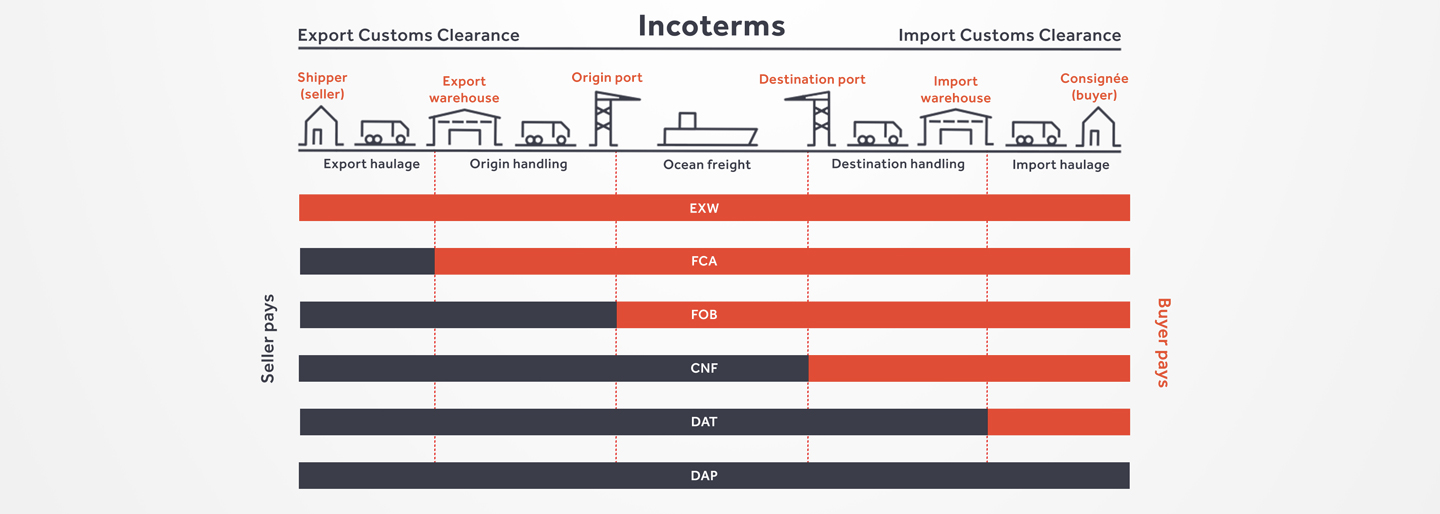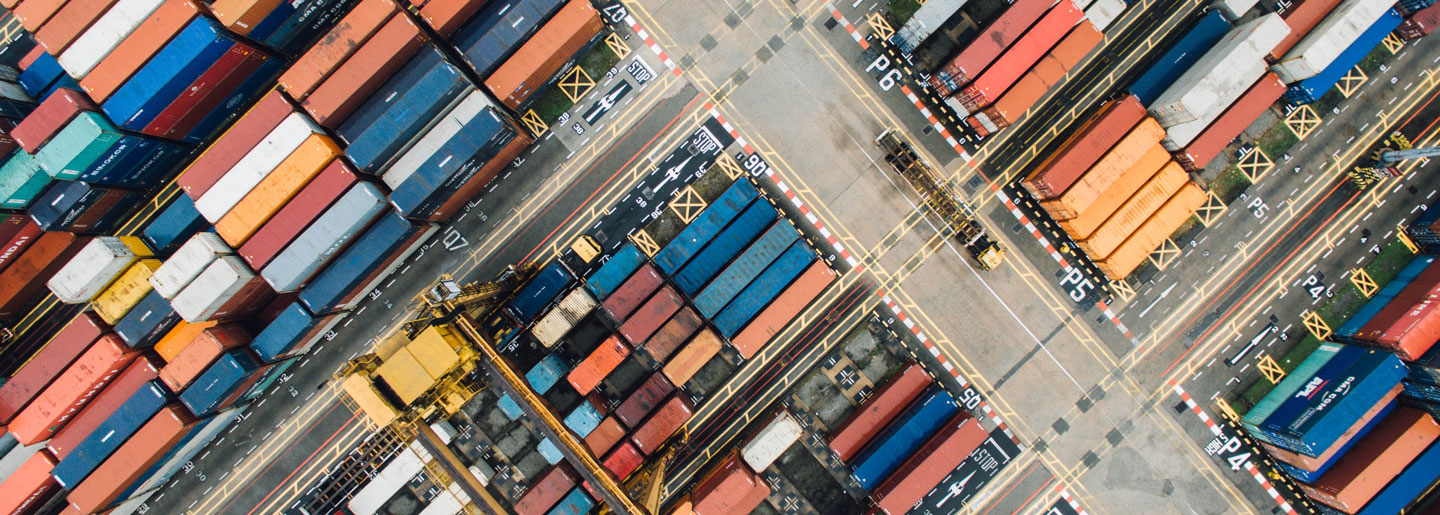Are you wondering what shipping costs consist of and how they are calculated? As an importer, you might already be aware that the total cost of a product includes three costs: The cost of the product (which you pay your supplier), the cost of transportation (which you pay a freight forwarder), and the cost of duty and sometimes VAT on your goods (which you pay your local customs and tax authorities). This post deals with the costs associated with transportation.
The 7 steps of international shipping
Whether you are new to the transport industry or if you already have some experience with international trade, with this post, we wish to help you understand the transport process, and with these basics provide you with the full overview of how shipping costs are determined and calculated.

In order to understand your future quotes and invoices more clearly, getting to know the seven steps of international shipping is a good starting point, as this is what all shipping costs are based on. Once you know the process of transportation, you will also get a better insight into what parts of it you pay for, and when.
Whether you trade overseas or within Europe, by sea, air or road, shipping costs will always be based on the following seven elements of the transport process:
- Export haulage (pick-up)
- Export customs clearance
- Origin handling (of the goods)
- Freight
- Import customs clearance
- Destination handling (of the goods)
- Import haulage (delivery)
Not all elements will be included in your shipping costs for every contract, because overseas transport will typically depend on the incoterms you and your supplier have agreed upon, and transport within Europe will depend on how much cargo you have. Below we have identified when you pay for which elements of the transport process.
What does shipping costs include?
When you are out searching for a price to get your newly purchased items home, it can be confusing to keep track of what costs are included in the freight forwarders’ quotes, and which are not. Below we try to specify which costs are typically included and when.
Overseas shipments
For overseas shipments, you have two options of getting your goods home: sea freight and air freight. Which of the seven elements of the transport process that are included in your freight rates will depend on the specific incoterms you and your supplier has agreed upon. This should be clearly stated on your invoice and indicates when the liability of the goods, as well as the shipping costs, shifts from your supplier to you.
Incoterms
Below we specify which costs you bear, depending on which incoterms are used for the specific trade. For imports, the most commonly used incoterms are FOB and EXW, and for exporting DAP and CFR terms often come in handy. For more information on the four, please keep reading.

FOB: Trading on FOB terms means that your supplier will be responsible for all local costs, ie. point 1-3 in the transport process: Delivery at the port, handling of the cargo, and export customs clearance. This leaves you with the responsibility of the remaining elements: Freight, import customs clearance, destination handling, and delivery to your door.
EXW: Trading on EXW terms means that you are responsible for the entire transport process, and therefore bear all costs associated with the transportation. In other words, a transport booking will include all transportation costs from your supplier’s door in, for example, Shanghai, China to your door in the UK.
CFR is an export term, and is basically the opposite of ‘FOB’. For this trading term, you as an exporter will hold the costs from your door in the UK to the destination port. However, the responsibility already shifts as soon as the cargo passes the ships’ rail. From the destination port costs will shift to your buyer, who will hold the remaining local costs, ie. import customs clearance, import handling and transportation to their door.
DAP is also an incoterm related to export. For this one, you as an exporter are responsible for the entire transport process from your door to your buyers door in any given country. Therefore, you also bear all the costs associated with the transportation.
Read more about the different incoterms here.
Common to the four incoterms mentioned above, they only reflect cost associated with the transportation. For instance, should you be interested in adding a transport insurance to insure your goods while in transit, this will typically be an additional cost.
In terms of duty on your imported goods, this should be settled with your local customs authority, and it is your own responsibility to check this amount, as duty is not related to the transportation, but to the specific goods you are importing.
Road transport within Europe
Within Europe, most transportation is done by truck, and is commonly referred to as regular road transportation. This type of service is always door-to-door (EXW), and will therefore always include pick-up and delivery. However, if you are importing a larger amount of goods (the equivalent to three pallets or more), you are likely to avoid costs for points three and six in the transport process (handling of the goods), as your goods will be collected and delivered directly with a large export truck without any transshipments. The term ‘export truck’ refers to the truck that runs between the warehouse at origin and the warehouse at destination, from where the goods will be delivered with a different, usually a bit smaller, truck. The same goes for collection.
For road transportation within Europe, a quote will typically include the freight from point A to point B plus customs clearance. What is typically not included is anything else than the above mentioned. For example, if you need a truck with a lift to load and unload the goods, you want pickup or delivery at two or more different addresses, you need collection or delivery at a specific time, or if you need an especially fast transport, then it will cost extra.
So, all conceivable forms of special handling will result in additional costs, and will have to be requested and paid for upon booking your transport.
There are neither customs nor VAT to be payed on your goods when you import from countries in the EU. This is due to our Common Customs Union, where goods can move freely. Here you can read more about importing goods from the EU.
How prices are determined for overseas shipments
When comparing sea and air freight, the price will depend on the route and the type of goods. This is because ships are limited by space and aircraft are usually limited by weight. Therefore, the heavier the load, the greater the fluctuations in the prices. Below we have specified how the prices are calculated.
Sea freight
For sea freight, there are two different ways of shipping your goods: LCL and FCL. LCL (Less than Container Load) refers to a break bulk shipment, which is relevant for ‘smaller’ shipments. For this type of shipment, several importers ‘share’ a container, and it is of general understanding that shipping LCL is relevant for shipments that are less than 15 cubic meters. On the contrary, FCL (Full Container Load) is relevant when you are sending more than 15 m3 and in this case will have the opportunity to fill up an entire container yourself.
LCL prices are calculated on the basis of volume (cubic meter / m3), which is a term referring to how much space the cargo takes up. The greater the volume, the higher the price. If you are trading on EXW-terms, it will also affect the price depending on where in the country collection takes place. For example, if your goods are to be collected several hundred kilometers inland in China, then the cost for pick-up will be significantly higher than if your supplier resides in Shanghai, which is located by the coast and has it’s own seaport.

Below you can see an example of how the total transportation cost is divided according to the transport process. The example is based on 2 m3 and 500 kg EXW Shanghai to London:
Export haulage (Pick-up): GBP 90
Export customs clearance: GBP 11
Origin handling: GBP 83
Freight: GBP 59
Import customs clearance: GBP 35
Destination handling: GBP 68
Import haulage (delivery): GBP 48
Total transportation cost: GBP 394
As you can see from the above depiction, the freight itself is not very expensive. On the other hand, pickup, and handling of the goods will usually be the most costly expenses.
Read more about calculating LCL rates here.
FCL prices
The price for a full container fluctuates quite a bit. This is due to the basic principle of supply and demand, which applies to most other markets as well. If a given trade route experiences an over capacity of container ships, then the price decreases, and vice versa. In addition, currency, oil, and other fees, such as congestion, war risk surcharge, and peak season surcharge will also affect the price. These fluctuating prices are noticeable when you inquire for transportation quotes at Transporteca or from any other freight forwarder month by month, where the rates are updated.
According to the above example, the LCL rates show far less fluctuations, as the freight itself is only a small part of the total cost for LCL shipments. Instead the heavy costs are tied up in collection, export and import handling, and delivery.

Air freight
The time perspective is undoubtedly the most prominent difference between sea freight and air freight. If you need to get your goods home fast, you are forced to send your shipment by air, which has a transit time of 3-12 days depending on your preferred service, and where in the world you are importing from.
Air freight can be divided into two categories: standard air freight and courier services. Below we will review both modes of transport in terms of how the price calculation takes place.
Standard air freight
The price for standard air freight is determined by the so-called ‘volumetric weight’, perhaps better known as ‘chargeable weight’. In practice this means, that the price will be calculated on the basis of a pre-determined DIM factor (dimensional factor) set by the respective airline company, and based on the aircraft’s loading capacity.
The volumetric weight refers to a shipment’s density, which reflects the volume in relation to its weight. To determine your shipments volumetric weight, simply divide your shipments volume in cubic centimeters by 6,000. This corresponds to the regular DIM factor per. kilogram for standard air freight, and also corresponds to 166.67 kilograms per cubic meter.
For example, if you have 1 m3 of goods weighing 100kg, then you are required to pay for 167 kg regardless of the actual weight. If you have 1m3 and 500 kg, you will of course have to pay for the full 500 kg.

The price will depend on the specific route, and is determined by the airline on the basis of supply and demand–just like it applies to sea freight. Additionally, the forwarders ability to buy will affect the price: for example, if a freight forwarder has large volumes from Bangladesh to the UK because they have some big customers importing jeans, they can probably also offer other customers a good rate on this route.
Furthermore, air freight prices will often be reflected in exchange rates, fuel surcharge, and transit time, meaning prices increase when transit time decreases.
Sea freight versus air freight
As a rule of thumb, you can expect if your cargo is less than 0.5 m3 and weighs less than 100 kg, air freight can often compete with sea freight price wise, as the minimum chargeable volume for sea freight is 1 m3–even if the actual volume is less. When you import more than 0.5 m3 and 100 kg, sea freight will always be the cheapest option. However, this is naturally also reflected in the transit time, which depending on the route, can take up to 43 days from eg. China.
Courier
You may have heard of DHL, FedEx , UPS, and TNT already. These are all some of the major players in the field of courier services, and common for all of them is that they are dedicated transport companies with their own aircrafts, carriers, and distribution centers. This is a significant difference from standard air freight, where transport of passengers is the primary product, and cargo transport is the by-product. Couriers are best known for handling smaller package shipments, but they can actually handle larger palletized shipments as well.
These couriers’ strength is clearly their infrastructure, which is optimized and automated for an exceptionally efficient handling of various cargo shipments that can move from one continent to another within 48 hours.
As for standard air freight, weight is also essential for calculating prices for courier transport. Therefore, you will in some cases have to take the volumetric weight of your goods into account when calculating transport prices.
To determine which weight the price calculation is based on, you must first establish which of the two categories your shipment falls in under: Volumetric weight or actual weight. The heaviest of the two will be the ‘billable weight’, which is used to calculate shipping costs for both standard air freight and courier services. In other words, if the volumetric weight exceeds the actual weight, then this will be the base for your billable weight.
For courier shipments, the chargeable weight will typically be 200-250 kg. per. cubic meter depending on the specific courier. This also corresponds to a DIM factor of 5,000 or 4,000 cubic centimeter per. kilogram. This information will typically be available on the courier’s website.
Example: Let’s say you are importing a package of 0.3 m3 and an actual weight of 25 kg. To calculate the volumetric weight to know which of the categories your goods fall into, which will determine the price of your shipment, you should first and foremost convert m3 to cm3, ie. 0.3 x 1,000,000 = 300,000 cm3. Then you divide by 5,000 (or another fixed factor set by the specific courier) = 60 kg.
By calculating this we have determined the volumetric weight to be 60 kg, which is higher than the actual weight of 25 kg, and in this case you will have to pay for the 60 kg in freight costs, even though your package actually weighs less. This is the basic principle of volumetric weight.
How are shipping costs calculated for road transportation?
As mentioned above, transportation within Europe will usually be handled by truck, and it will always be a door-to-door shipment (EXW). The trucks typically travel according to fixed time schedules across Europe with daily or weekly departures, so you can often expect pick-up the day after you have booked your transport.

Road transportation can often be divided into the following categories: LTL (Less than Truck Load), Partloads, and Full Loads or FTL (Full Truck Load). The definitions are often used interchangeably from one freight forwarder to another, however, below we try to outline the meaning of each of them:
LTL is typically referring to a shipment of 1-2 pallets, and in practice means that you buy X number of pallet positions in a truck, sharing transportation costs with other importers. Most often, the goods will be picked up by a smaller truck and then transported to a warehouse where the goods will be reloaded onto the large export truck. When the goods arrive in the destination country, it goes to the nearest warehouse for a reloading, before the goods finally go out for delivery with a smaller truck.
Partloads often describe shipments of three or more pallets. This type of shipment will often be collected and delivered directly by the large export truck. The export truck will still make a stop at the warehouse to be loaded with other LTL-shipments, but you avoid the handling costs at both warehouses, as the goods will not be reloaded. This calculation only makes sense if the shipment is 3+ pallets, otherwise the handling costs will typically be cheaper than sending the large export truck to both the supplier and the recipient. Partloads are also good for odd-sized goods, which can be difficult for the warehouse to handle, for example, a boat on a trailer.
FTL refers to a full truck load, which means that you are the sole customer and have purchased the full capacity of a truck, ie. 33 pallets positions, or about 90 m3 for regular curtain trailers.
For road transport, the term ‘loading meter’ is also used to calculate the truck’s capacity. A regular curtain trailer can accommodate 13.6 loading meters.
When you buy the full capacity of a truck, you also avoid the costs for handling and transshipments, as the export truck travels directly from the supplier to you. This also means that you can expect a somewhat shorter transit time.
As a rule of thumb, it requires at least half a truck load, before buying a full load is a better option than buying a partload shipment.
Most forwarders and lorries have fixed prices on LTL shipments that depend on volume, weight, and the distance. Each country is pre-divided into zones, and the price is based on the zones from which the transport starts and ends. In this way the freight forwarder can easily find a price by checking their respective zone cards. In addition, they will charge you an oil fee, and special handling of your goods will also cause additional fees.
Comparing regular road transportation and courier services
The formerly mentioned couriers also work within Europe, offering fast and cheap transportation of smaller parcel-shipments. Typically, if a shipment is less than 1 m3 and weighs less than 400 kg, it will usually be advantageous to use a courier service to handle your transportation. Alternatively, if you send more than 1 m3, weighing more than 400 kg, then the cheapest option will be by regular road transportation.
Nonetheless, there will be a smaller time perspective to consider as well, and for some this will play a role in their decision-making. A courier will typically deliver anything across Europe in 2-3 days, whereas a lorry will need 4-8 days. However, full load shipments (FTL) can be done faster as the truck goes straight from supplier to consignee, without any transshipments.

Do not forget!
Here is a brief summary of the main points above.
It is important to keep in mind that transport prices do not always include everything. For road transport within Europe, transport from point A to point B plus customs clearance will always be a part of the price, but be aware that special handling of the goods will always cause additional expenses. Therefore, be sure to check with your chosen freight forwarder if you, for example, need a truck with a lift or if you want pickup at a specific time.
For overseas transport, costs depend on the agreed incoterms, and based on the specific trading terms, you also know who bears the responsibility and costs of each of the seven parts of the transport process.
The shipping costs you find on transporteca.co.uk, or you get from another forwarder are always only related to the transportation. This also means that costs related to your specific goods, ie. duty, and possibly VAT when importing as a private person, must be paid separately and must be settled with your local customs authorities.
How do I find shipping costs via transporteca.co.uk?
We hope this post has clarified any questions, and that you can move forward feeling confident and well equipped for your next transport booking, to effortlessly select the best transport solutions correlating to your needs.
At Transporteca you can look up shipping costs for sea, air, and road transportation quickly and easily. You just select the type of cargo you are transporting: break bulk, pallets, or parcels, and specify the the cargo details. Then we will supply you with the best all-in prices–with no hidden fees. Once you have found the solution that suits your needs, you can book the transportation directly online. Next, your selected freight forwarder and your supplier will automatically be notified of your transport booking.